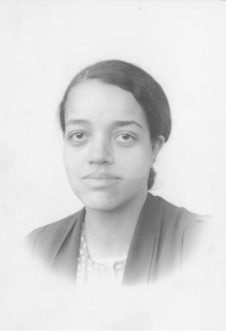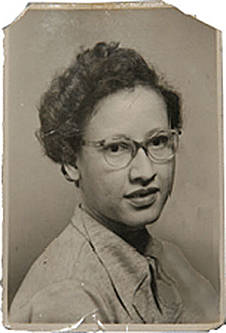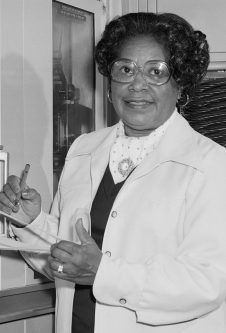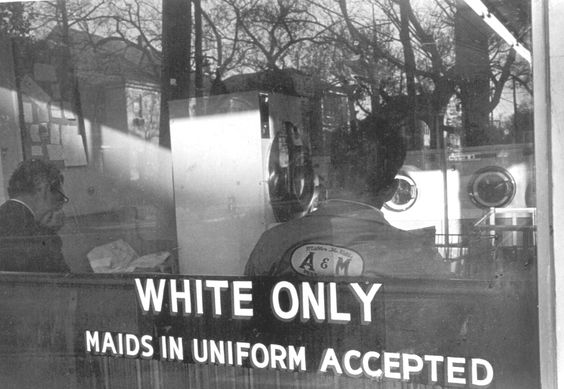
TWM offers the following worksheets to keep students’ minds on the movie and direct them to the lessons that can be learned from the film.
Teachers can modify the movie worksheets to fit the needs of each class. See also TWM’s Historical Fiction in Film Cross-Curricular Homework Project .
From the 1930s to the advent of the digital computer in the early 1960s, several hundred female “human computers” were hired by the federal government. Their task was to calculate numbers and to solve the equations necessary for new generations of airplanes, the first American rockets, and the first U.S. manned space flights. They worked with pen, paper, and analog calculating machines. The need for these workers was so great that even in those days of rampant racial discrimination, black women were hired as well as whites. The human computers reported to the Langley Research Center in Hampton, Virginia, operated by the National Advisory Committee on Aeronautics (NACA) and its successor, the National Aeronautics and Space Administration (NASA).
“Hidden Figures” is the story of three black women who made important contributions to the U.S. Space program both before and after the “human computers” were replaced by digital computers. The three real-life heroines of the movie are:
The women face entrenched racist and sexist attitudes. However, their persistence and outstanding work boost the U.S. presence in space and blaze a path forward for achievement based on merit. The movie closely follows Margot Shetterly’s meticulously researched, award-winning, 2016 historical work of the same name. The validity of the film is confirmed by Katherine Johnson’s posthumously published memoir, My Remarkable Journey, at page 7, in which she states, that, “75% of what was shown in the movie is accurate,”
Selected Awards: 2017 Academy Awards Nominations: Best Picture; Best Performance by an Actress in a Supporting Role (Octavia Spencer); Best Adapted Screenplay; 2017 Golden Globe Nominations: Best Performance by an Actress in a Supporting Role in a Motion Picture (Octavia Spencer); Best Original Score – Motion Picture; 2017 Screen Actors Guild Awards: Outstanding Performance by a Cast in a Motion Picture.
Featured Actors: Taraji P. Henson as Katherine G. Johnson; Octavia Spencer as Dorothy Vaughan; Janelle Monáe as Mary Jackson; Kevin Costner as Al Harrison; Kirsten Dunst as Vivian Mitchell; Jim Parsons as Paul Stafford; Mahershala Ali as Colonel Jim Johnson; Aldis Hodge as Levi Jackson; Glen Powell as John Glenn; Kimberly Quinn as Ruth; Olek Krupa as Karl Zielinski; Kurt Krause as Sam Turner; Ken Strunk as Jim Webb.
Director: Theodore Melfi
“Hidden Figures” is well-crafted historical fiction that is inspirational for everyone, especially for girls and students of color. It tells a story that was “never hidden, but unseen.” The Mses. Vaughan, Johnson, and Jackson are outstanding role models for young people trying to break through barriers of prejudice and glass ceilings in employment. Additionally, the film provides a historical link to today’s STEM and STEAM initiatives in schools and can encourage students to seek out programs that will reinforce their skills and lead to careers in science and technical fields. The movie provides excellent opportunities for class discussion and assignments. [The quotation “never hidden, but unseen” is from Hidden to Modern Figures: Frequently Asked Questions , a NASA website, accessed April 24, 2017.]
Students will be introduced to: (1) a fascinating episode in American history; (2) the struggles of black women to reach racial and gender parity in the workplace; (3) the accomplishments of black women in technical fields and their contributions to America’s efforts in aeronautics and the space race of the second half of the 20th century; (4) the disruptive influence of WWII and the Cold War on sexist employment practices and racial discrimination; and (5) a few of the despicable aspects of Jim Crow.
Watch the film with your children and tell them that the three leading actresses in the movie portray women who actually worked at NASA and that the film gives us a good idea of their experiences. Also, be sure to put the film into perspective. Hidden Figures doesn’t show the millions of people denied jobs due only to the color of their skin. It doesn’t show the full extent of the humiliation endured by black citizens of the United States living in the South during the “Jim Crow” era, the late 1800s through to the 1960s. During that time African Americans were humiliated on a daily basis and denied access to public facilities. In addition, they suffered from discrimination in education, employment and housing. At times they were beaten and lynched.
Beginning with small steps in the 1940s (President Roosevelt’s executive orders requiring the hiring of some African Americans in defense industries) and gaining strength each year with the Civil Rights Movement, the United States has developed a growing tradition of inclusion and equal opportunity for minority citizens that runs counter to the shameful tradition of racism. (As of January 2022 millions of African Americans have good jobs and have entered the middle-class. We have elected a black President, twice. There have been two black Secretaries of State and a black man heads the Department of Defense.) The work of well-intentioned Americans is to continue to bend the moral arc of the Universe toward reaching the ideals of the the Declaration of Independence.



The US National Advisory Committee on Aeronautics (NACA) was the forerunner of NASA, the National Aeronautics and Space Administration.
NACA was established in 1917, at the end of the First World War, on the grounds of Langley Air Force Base in Hampton, Virginia. It was part of the effort to develop America’s fledgling aeronautical sector. In the mid-1930s, Langley began hiring female, or “girl,” mathematicians to compute solutions to equations using pen, paper, and analog adding machines. The women were called “computers.”
By the 1930s it was clear to American leaders that crucial battles in the next war would be fought in the air. It was therefore essential to transform America’s unimpressive aircraft arsenal into a powerful aerial armada. This opened the door a crack for women at Langley. During WWII, in the 1940s, when many of the men were sent to soldier in Europe and the Pacific, the need for manpower to fuel the American war materiel machine became a need for woman power as well. Thus, the door for women to serve in technical fields opened a little further.
Melvin Butler, the man responsible for filling the burgeoning job positions at Langley, devised recruitment tools designed to appeal to housewives looking for a different kind of work. His advertisements exhorted them to, “Reduce your household duties . . . .” He issued a challenge, citing the need for “women who are not afraid to roll up their sleeves . . . .” Shetterly, p. 5.
While increasing numbers of women were being integrated into the workforce, another social change was underway. In 1941, as American industry geared up to produce the weapons to fight WWII, a group of civil rights activists led by A. Philip Randolph, head of the union for black male porters, men who worked as sleeping car attendants on America’s railroads. Mr. Randolph and others formed the “March on Washington Movement.” They demanded that President Roosevelt end racial discrimination in hiring for the defense industry and threatened a massive march on Washington, D.C., to protest racial segregation in employment and in the military. Randolph is credited with forcing FDR to issue Executive Order 8802 which prohibited racial discrimination in hiring for national defense industries and established the Fair Employment Practices Commission (FEPC). While Executive Order 8802 didn’t end discrimination against African Americans in defense industries, it did lead to some job gains for black workers.
In 1943, employment applications began arriving at Langley from black women. For example, Dorothy Vaughan, one of the three main characters in the film, came to NASA when she saw a federal civil service bulletin intended to recruit white women. Even though there was still discrimination against “Negroes,” the relentless Mr. Butler began hiring well-qualified black women to work as human computers. He got around the scandalous implications of racial equality by setting up a segregated work area for the smaller number of “colored” computers. It was called West Computing because it was located in a building at Langley’s western end. White females worked at East Computing. Shetterly, p. 8.
Propelled by the Civil Rights Movement, opportunities for blacks to work in the aeronautics and space industries opened up a little more during the 1950s and 1960s. Spurred by Soviet Russia’s Sputnik, the first man-made object to orbit the earth, the U. S. recognized the need to provide technical and scientific training to students and to move them into positions that could benefit America’s reach for the heavens. The administration of President Dwight D. Eisenhower responded by increasing the resources that went into scientific research and training. Additionally, U. S. leaders were engaged in selling the American way of life to non-aligned nations during the Cold War. They worried that Jim Crow segregation and the second-class citizen status of American “Negroes” would not play well in the court of international opinion. Shetterly, p. 104.
In the American South after the Civil War and Reconstruction, the white power structure (formerly the slave-owning class) reasserted itself and imposed a racist system through “Jim Crow” laws and customs. These were designed to denigrate and suppress African Americans. One of the pillars of Jim Crow was separate sanitary facilities. Restrooms and drinking fountains were designated “White Only” or “Colored.” There were many fewer restrooms and drinking fountains for blacks than there were for whites. Every day in cities, towns, and villages across the South, African Americans faced personal emergencies when the only restroom available — for what could quickly become an urgent need — was forbidden territory. A black person in that situation had to find some alternative or run the substantial risk of arrest or a beating for using a “White Only” restroom. This disgraceful practice is treated semi-humorously in the film — cinematically, there was no other way to present it. However, the unavailability of restrooms was no laughing matter for African Americans who had to live under Jim Crow.

(The white husband of this writer was once detained, at age 15, by police for defacing a “White Only” sign on a laundromat in Tallahassee, Florida. It was Halloween night in 1963. Hard at work on his task, he heard a sound behind him, looked over his shoulder, and saw a police cruiser come to a stop. He was released after a few hours on the condition that he clean up the sign. An African-American teenager would probably not have been treated in such a lenient fashion.)
Ms. Shetterly’s book describes the proliferation of black middle-class neighborhoods around the Langley campus in the middle of the 20th Century. Despite economic and professional gains by African Americans since that time, segregation in housing hasn’t changed much.
… Brown University’s US2010 Project [has shown that] in 1940, the average black lived in a neighborhood that was 40 percent white. In 1950 it fell to 35 percent — where it remains today. This average, of course, aggregates data from many neighborhoods where blacks have virtually no exposure to whites, and others where integration is advanced. Nonetheless, by this measure there has been no progress in reducing segregation [in housing] for the last 60 years. Commentary by Richard Rothstein for the Economic Policy Institute, February 3, 2012, accessed on January 9, 2022.
African-American newspapers, journals, and magazines of the 1940s and 1950s were inspiring and influential in the segregated lives of America’s black citizens. They contributed to initiatives to integrate society and achieve economic and social justice. In WWII these publications promoted the “Double V Campaign:” Victory overseas in the war and victory over discrimination at home. This campaign intentionally echoed the concept of the double consciousness of blacks in a racist society, articulated by the African-American intellectual W. E. B. Du Bois, and analyzed in his signature book, The Souls of Black Folk. Dubois wrote that blacks faced a nearly impossible task in constructing internally positive personal identities because they were forced to act in ways that were acceptable to an oppressive white society. To do this they had to see themselves through its eyes: devalued and negatively stereotyped. Shetterly, p. 33. This psychological conundrum confronts every oppressed group.
Euler’s Method, employed by Katherine Johnson in her breakthrough calculations for John Glenn’s Friendship Seven orbit, was devised in the 18th century. The idea behind Euler’s Method is to approximate a curve using the concept of local linearity to join multiple small line segments of the curve. Mathscoop.com. The method was one of many mathematical innovations developed by Leonhard Euler of Switzerland, one of the great mathematicians of his time. Euler lived from 1707 to 1783, dying just seven years after the U.S. declared independence from Great Britain.